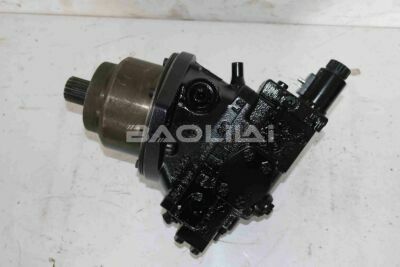Is there any relationship between hydraulic motor displacement and reducer
Hydraulic motor displacement and reducer (gearbox) are two independent components used in hydraulic systems, and they are related in that they can be combined to control the output speed and torque of the hydraulic system. Let me explain the relationship:
1. Hydraulic motor displacement:
Hydraulic motor displacement refers to the volume of fluid the motor can displace or consume per revolution (usually measured in cubic inches per revolution or cubic centimeters per revolution). It is a measure of a motor's ability to convert hydraulic oil flow and pressure into mechanical rotational power.
2. Reducer (gearbox):
A reducer, often called a gearbox or gear reduction device, is a mechanical component used to control the speed and torque of a rotating shaft. It consists of a set of gears of different sizes that amplify or reduce the speed and torque of the hydraulic motor's input shaft.
The relationship between hydraulic motor displacement and reducer is how they are used together in a hydraulic system:
Use a reducer to control speed and torque: When a hydraulic motor of a specific displacement operates at a fixed flow and pressure, it will produce a certain speed and torque output. If it is necessary to change the output speed or increase the torque, a reducer can be introduced between the motor and the driven equipment. By choosing the appropriate gear ratio in the reducer, you can increase torque while reducing speed, and vice versa.
Sizing the reducer: The reducer and its gear ratio should be selected based on the specific requirements of the application, such as required output speed and torque. The displacement of a hydraulic motor affects initial speed and torque, and the role of the reducer is to modify these parameters to suit the application.
H1-B-060-A-A-L1-BA-N-B-PA-DS-HS-S-A-10-NP-016-N-00-NNN H1B060AAL1BANBPADSHSSA10NP016N00NNN
H1-B-060-A-A-L1-BA-N-B-PA-DS-GS-S-N-NN-NP-030-N-00-NNN H1B060AAL1BANBPADSGSSNNNNP030N00NNN
H1-B-060-A-A-L1-BA-N-B-PA-DS-GS-S-N-NN-NP-000-N-00-NNN H1B060AAL1BANBPADSGSSNNNNP000N00NNN
H1-B-060-A-A-L1-BA-N-B-PA-DS-GS-S-A-10-NP-016-N-00-NNN H1B060AAL1BANBPADSGSSA10NP016N00NNN
H1-B-060-A-A-L1-BA-N-B-PA-DS-GS-S-A-05-NP-000-N-00-NNN H1B060AAL1BANBPADSGSSA05NP000N00NNN
H1-B-060-A-A-L1-BA-N-B-PA-CS-GS-S-N-NN-NP-000-N-00-NNN H1B060AAL1BANBPACSGSSNNNNP000N00NNN
H1-B-060-A-A-L1-BA-N-B-PA-CS-GS-S-N-NN-NN-000-N-00-NNN H1B060AAL1BANBPACSGSSNNNNN000N00NNN
H1-B-060-A-A-L1-BA-N-B-PA-CS-GS-B-A-05-NP-000-N-00-NNN H1B060AAL1BANBPACSGSBA05NP000N00NNN
H1-B-060-A-A-L1-BA-N-B-PA-CS-AS-S-N-NN-NP-000-N-00-NNN H1B060AAL1BANBPACSASSNNNNP000N00NNN
H1-B-060-A-A-L1-BA-N-B-PA-CS-AS-S-N-NN-NN-000-N-00-NNN H1B060AAL1BANBPACSASSNNNNN000N00NNN
H1-B-060-A-A-L1-BA-N-A-PB-VS-AS-S-A-05-NP-012-N-00-NNN H1B060AAL1BANAPBVSASSA05NP012N00NNN
H1-B-060-A-A-L1-BA-N-A-PB-VS-AS-S-A-05-NN-012-N-00-NNN H1B060AAL1BANAPBVSASSA05NN012N00NNN
H1-B-060-A-A-L1-BA-N-A-PB-VN-AN-N-A-10-NP-000-N-00-NNN H1B060AAL1BANAPBVNANNA10NP000N00NNN
H1-B-060-A-A-L1-BA-N-A-PB-VN-AN-N-A-05-NP-012-N-00-NNN H1B060AAL1BANAPBVNANNA05NP012N00NNN
H1-B-060-A-A-L1-BA-N-A-PB-VN-AN-N-A-05-NN-012-N-00-NNN H1B060AAL1BANAPBVNANNA05NN012N00NNN
H1-B-060-A-A-L1-BA-N-A-PB-CS-GS-S-A-10-NP-000-N-00-NNN H1B060AAL1BANAPBCSGSSA10NP000N00NNN
H1-B-060-A-A-L1-BA-N-A-PB-CS-GS-S-A-10-NN-000-N-00-NNN H1B060AAL1BANAPBCSGSSA10NN000N00NNN
H1-B-060-A-A-L1-BA-N-A-PB-CS-GS-B-N-NN-NP-012-N-00-NNN H1B060AAL1BANAPBCSGSBNNNNP012N00NNN
H1-B-060-A-A-L1-BA-N-A-PB-CS-GS-B-A-10-NP-000-N-00-NNN H1B060AAL1BANAPBCSGSBA10NP000N00NNN
H1-B-060-A-A-L1-BA-N-A-PB-CS-GS-B-A-10-NN-000-N-00-NNN H1B060AAL1BANAPBCSGSBA10NN000N00NNN
Matching Motor Displacement and Reducer: When designing a hydraulic system, it is important to select a hydraulic motor whose displacement matches or closely matches the application requirements. This helps ensure that the motor can deliver the required speed and torque under specified operating conditions. However, if the selected motor's displacement does not provide the precise speed and torque characteristics required, a reducer can be used to fine-tune the output to meet these requirements.
Efficiency Considerations: When using a reducer in a hydraulic system, it is important to consider the efficiency of the system. The gears in the reducer create mechanical losses that affect the overall efficiency of the hydraulic system. Choosing the right gear design and quality can help minimize these losses. Additionally, using a reducer with the proper gear ratio can help improve the overall efficiency of the system by matching motor performance to application requirements.
Control and Precision: In certain applications, especially those that require precise control of speed and torque, the combination of hydraulic motor displacement and reducer can provide a flexible and efficient solution. By adjusting the gear ratio in the reducer, the system's output speed and torque can be finely controlled, making it suitable for applications such as industrial automation, conveyor systems, and machine tools.

Maintenance and Reliability: Both hydraulic motors and reducers wear out over time. Proper maintenance is critical to ensuring the long-term reliability of your system. Regular inspection, lubrication, and, if necessary, replacement of gears in the reducer will help maintain system efficiency and prevent unexpected failure.
Adaptability to load changes: Hydraulic systems often encounter changing loads in practical applications. A combination of hydraulic motors and reducers with specific displacements can help accommodate these load changes. By adjusting the gear ratio in the reducer, you can effectively change the speed and torque output to adapt to changing load requirements. This adaptability is especially valuable in applications where loads change frequently or are unpredictable.
System size and weight: The choice of hydraulic motor displacement and the use of a reducer also affect the size and weight of the hydraulic system. In some cases, higher displacement engines may be larger and heavier. Using a reducer with an appropriate transmission ratio helps reduce the overall size and weight of the system, making it more compact and easier to install in tight spaces or mobile equipment.
H1-B-060-A-A-L1-BA-N-A-PA-DS-HS-S-A-10-NP-000-N-00-NNN H1B060AAL1BANAPADSHSSA10NP000N00NNN
H1-B-060-A-A-L1-BA-N-A-PA-DN-GN-N-N-NN-NP-000-N-00-NNN H1B060AAL1BANAPADNGNNNNNNP000N00NNN
H1-B-060-A-A-L1-BA-N-A-PA-CS-GS-S-A-10-NP-020-N-00-NNN H1B060AAL1BANAPACSGSSA10NP020N00NNN
H1-B-060-A-A-L1-BA-N-A-PA-CS-GS-S-A-10-NP-012-N-00-NNN H1B060AAL1BANAPACSGSSA10NP012N00NNN
H1-B-060-A-A-L1-BA-N-A-PA-CS-GS-S-A-10-NN-012-N-00-NNN H1B060AAL1BANAPACSGSSA10NN012N00NNN
H1-B-060-A-A-KH-KA-M-B-RA-VS-AS-S-A-05-NP-014-N-30-NNN H1B060AAKHKAMBRAVSASSA05NP014N30NNN
H1-B-060-A-A-K2-KA-N-B-RB-CN-GN-N-A-05-NP-024-N-28-NNN H1B060AAK2KANBRBCNGNNA05NP024N28NNN
H1-B-060-A-A-K2-K2-N-B-RB-VS-AS-S-A-10-NP-012-N-21-NNN H1B060AAK2K2NBRBVSASSA10NP012N21NNN
H1-B-060-A-A-K2-K2-N-B-RB-VS-AS-S-A-10-NN-012-N-21-NNN H1B060AAK2K2NBRBVSASSA10NN012N21NNN
H1-B-060-A-A-K1-KA-N-B-RB-VN-AN-N-A-10-NP-020-N-22-NNN H1B060AAK1KANBRBVNANNA10NP020N22NNN
H1-B-060-A-A-K1-KA-N-B-RB-CN-GN-N-N-NN-NP-035-N-28-NNN H1B060AAK1KANBRBCNGNNNNNNP035N28NNN
H1-B-060-A-A-K1-K1-N-B-RA-DS-HS-S-A-10-NP-019-N-21-NNN H1B060AAK1K1NBRADSHSSA10NP019N21NNN
H1-B-060-A-A-K1-K1-N-A-RA-VS-AS-S-A-05-NP-025-N-24-NNN H1B060AAK1K1NARAVSASSA05NP025N24NNN
H1-B-060-A-A-K1-K1-N-A-RA-VS-AS-S-A-05-NN-025-N-24-NNN H1B060AAK1K1NARAVSASSA05NN025N24NNN
H1-B-060-A-A-K1-K1-N-A-RA-DS-GS-S-A-10-NP-012-N-17-NNN H1B060AAK1K1NARADSGSSA10NP012N17NNN
H1-B-060-A-A-HF-HF-N-B-TA-VN-AN-N-N-NN-NN-015-Z-00-NNN H1B060AAHFHFNBTAVNANNNNNNN015Z00NNN
H1-B-060-A-A-HF-HF-N-B-TA-DN-GN-N-N-NN-NN-018-Z-00-NNN H1B060AAHFHFNBTADNGNNNNNNN018Z00NNN
H1-B-060-A-A-HF-HF-N-A-TB-VN-AN-N-N-NN-NN-000-Z-00-NNN H1B060AAHFHFNATBVNANNNNNNN000Z00NNN
H1-B-060-A-A-HF-HF-N-A-TA-VN-BN-N-N-NN-NN-033-Z-00-NNN H1B060AAHFHFNATAVNBNNNNNN033Z00NNN
H1-B-060-A-A-HE-HE-N-C-TB-VS-AS-B-A-05-NN-028-Z-00-NNN H1B060AAHEHENCTBVSASBA05NN028Z00NNN
Overcoming Inertia: In applications where high inertia needs to be overcome, such as starting a heavy load or rapidly accelerating a system, a larger displacement motor can be used in conjunction with a reducer to provide the necessary initial torque. Once the load starts moving, the gear ratio in the reducer can be adjusted to maintain the desired speed while saving energy.
System Cost: The choice of hydraulic motor displacement and use of reducer will affect the overall cost of the hydraulic system. Large displacement motors and complex reducers with various gear ratios can be more expensive than similar products. Engineers must consider the cost-effectiveness of components based on the requirements of the application and budget constraints.
In short, the relationship between the hydraulic motor displacement and the reducer in the hydraulic system is multifaceted. It involves a balance between motor displacement and reducer gear ratio to achieve the required speed, torque and adaptability to changing loads. Component selection should be based on the specific needs of the application, taking into account factors such as load requirements, system size, weight, efficiency and cost. By carefully considering these factors, engineers can design hydraulic systems that effectively meet application performance goals.
This article is published by the official website of Baolilai Hydraulics, please contact the author and indicate the source for reprinting:https://www.baolilai-pump.cn/news/1131.html






